Low cost community leaf litter composting pilot project ready to take off in Malleshwaram. Pic: Shree D N
Bangalore’s first low cost community leaf litter composting unit was inaugurated in Malleshwaram on April 24, 2014. Set in a roadside park on 8th Main Road before Yashwanthpur Circle, the project is a replication of an already-running model conceptualised by Ravi Kaushik, a resident of Malleshwaram, in his own frontyard.
The project aims to compost the leaves that fall in a particular season in Bangalore. Come winter, the roads of Malleshwaram that have a good tree cover are filled with variety of leaves. The leaves are usually swept and accumulated in various places, mixed with garbage and set ablaze by unknown elements.
Ravi Koushik, the brain behind the project Pic: Shree D N
Garbage contractors don’t take it as leaf litter does not add to the weight. This summer, such fire incidents have been rampant in Malleshwaram. Ranging from verbal wars between neighbours to police complaints, Malleshwaram saw it all. However, Ravi Koushik and some other residents of Malleshwaram started devising a solution to this. The result was this project.
People show interest to replicate the model
The event attracted many interested civilians who wanted to replicate the model in their wards, ranging from the nearby Mattikere to Sarjapur Road in the other end of Bangalore. MLA Ashwath Narayan and Corporator of the ward Muniraju visited the place.
Ravi Koushik, the brain behind the project, explained the procedures to everyone. The samples of leaf mold compost and coco peat were also kept for the visitors to see.
Ashwath Narayan distributed the money collected by selling the dug soil to Pourakarmiakas. He promised to support any such initiative driven by residents of his constituency. He stressed on greater participation by people to handle urban issues.
A barrier of coconut fronds built around the enclosure Pic: Shree D N
Health inspector of the ward Rahmathulla Khan, Solid Waste Management Round Table member Sandya Narayan, Malleshwaram Swabhimana Initiative president Sumati Rao and others were present on the occasion.
How is it prepared?
Two enclosures are built: One is to house the leaf litter collected throughout the year, between April and March, and the other is to make and house the leaf compost using alternate layers of the Carbon-rich leaves taken from enclosure-1 and the Nitrogen-rich Pongamia flowers starting Mid-March to first week of April.
The aim is to consume as much of the biomass generated by the trees as possible, produce good quality compost and to generate some income for the workers involved.
There is no bad odour involved in this project, the process is pretty simple and can be done by anyone. Parks, apartment complexes, bungalows with large gardens, school premises and play school premises are suitable for this.
Ravi Koushik explains the steps involved to Malleshwaram MLA Ashwath Narayan
The enclosure preparation: 200 to 300 sq.ft of space has to be identified to house two enclosures. The area should be easy to monitor, to avoid people from dumping garbage randomly. To build the enclosure, a pit is dug, coconut fronds are erected beside the pit and tied together to make an enclosure that holds the leaf litter.
What to do: The base of the pit is filled with tender coconut shells and palm shells that are thrown by the vendors, or any other biodegradable waste that takes a long time to decompose.
Coconut leaf litter is filled upon this. Upon this comes the leaf litter. The bottom layer of coconut waste will decompose and form good cocopeat in three years’ time.
The leaves are swept and collected separately and filled into the first enclosure throughout the year. Second enclosure will come into picture once Pongamia flowers start flowering in Bangalore. Pongamia flowers are the little purple-coloured flowers that start blooming in February end – March first week.
Residents from Sarjapur Road and other areas curiously watch the demonstration Pic: Shree D N
These nitrogen-rich flowers are collected and spread over the second enclosure, and a layer of half-composted leaves from first enclosure is laid on these. Thus the entire enclosure is filled with alternate layers of Pongamia flowers and leaf litter.
The leaf mold compost got from the first enclosure at this point is taken out, sieved and sold to the community. Malleshwaram model aims to give the proceed back to the BBMP workers who take care of the procedures throughout the year.
The half-empty first enclosure is repaired and used to fill the leaf litter again for the next year. The material in second enclosure gets decomposed by September of the second year. This is taken out, sieved and residue is added back, while the compost is sold. The procedure repeats every year.
A bbmp auto with collected leaves ready to empty its content to the pit. Pic: Shree D N
BBMP and residents to work together
While BBMP workers carry out the leaf collection process as part of their daily job, a residents’ committee will be active in monitoring the process. Malleshwaram model is being undertaken with the full support of BBMP and local peoples’ representatives, and driven by the team members of We Care for Malleshwaram and My Clean Malleshwaram.
This model helps eliminate the risk of garbage burning in summer. Instead it allows the nutritious leaf litter to go back to the nature in the form of compost. With more and more people going for vegetable gardening on their terraces or their backyards, the compost produced has good demand.
Ravi Koushik now aims to create a Health Out of Waste (HOW) trail at Sankey Tank Park, complete with composting and squarefoot vegetable gardening, which would inspire people to take a plunge.

Leaf mold compost, leaf compost and coco peat kept for display. Pic: Shree D N
For detailed model of the low cost community composting unit with timelines and methodology, write to Ravi Kaushik ( ravikoushik [at] yahoo.com ) or Vani Murthy (vanipolis [at] gmail.com ).
Related Articles
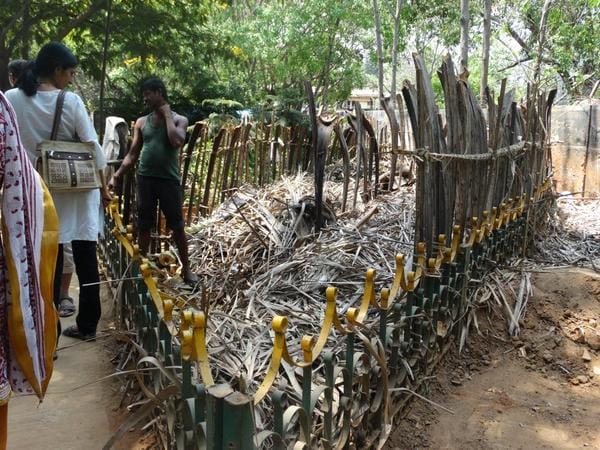
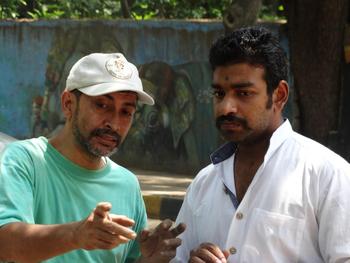
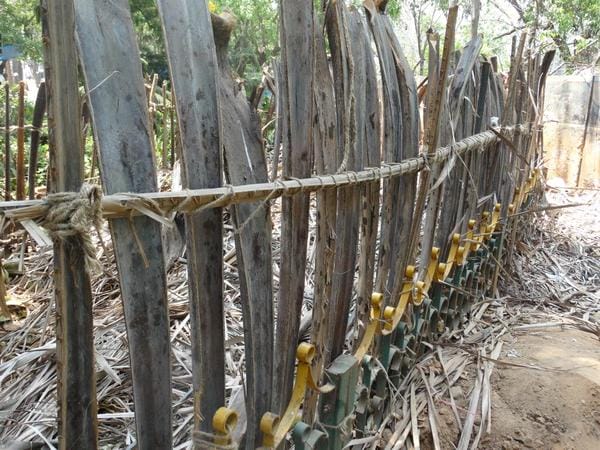
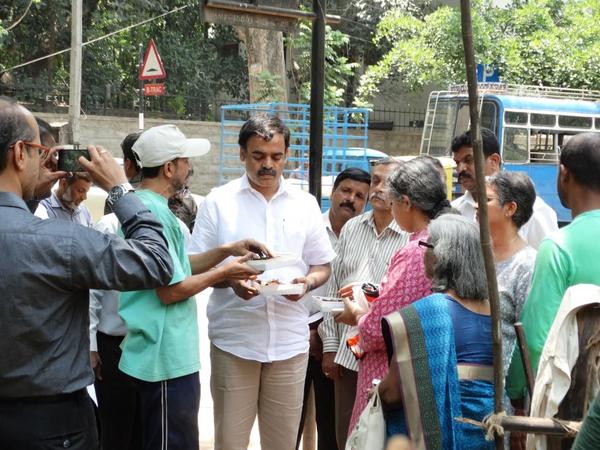
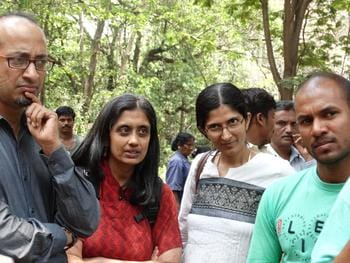
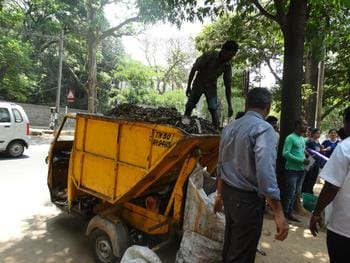
I am living in Trinity Woods & Acres which is having 285 apartments in it on Sarjapur Road( after Mantri Flora, ORR-Sarjapur Road junction). Although we are segregating wet waste and dry waste since long but litter of leaf waste is going on a big heap/ mound in the backyard of our campus, though it is a swept leaves’ waste but it could be used to procure manure by decomposting so all the residents could purchase and it could be used in the green patches and plants planted around our campus which is having most green space being the oldest one. I read your article but found that how to gain access to coconut peel and shells and flowers mentioned? Is it not possible to get the swept leaves collected and gets composted somewhere to buy back the manure ? Is it possible, pl. let us know, we shall be grateful.